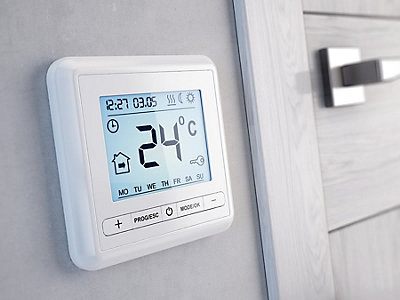Thermostats Match Technology to Lifestyle
February 2, 2018
A thermostat is a control point for the climate inside your home. It is a piece of technology – and for some people, technology makes life easier. For others, it seems to make it more complicated. Like with any tool, having the right one for the job makes all the difference. And in the case of a thermostat, selecting the right one is easier once you match the right features to suit your needs.
There are 5 main categories of thermostats, in order of increasing technology and features:
- Standard
- Non-programmable
- Programmable
- Remotely managed
- Learning
With so many choices, it can be confusing, or easy to get more than you need. The best place to begin is to consider which type of technology best suits your lifestyle.
Homebody
Two types of thermostats work well enough when you’re home a lot or don’t vary the temperature much.
- Standard -- Sometimes the best solution is the simplest one – and a standard thermostat is as simple as they come. You set the temperature you want, usually on a dial, and walk away knowing your heating and cooling system will keep your home interior at that temperature continually.
- Non-programmable -- A non-programmable thermostat is also a manual “set-and-done” device but is designed differently. This type of thermostat is more ascetic and blends better with your home’s décor. It also offers a large digital display which is easier to read, and easier to set with more precision.
On-the-go
If you’re more on-the-go with work or activities, a programmable thermostat gives you the choice: you can do a manual “set-and-done” or you can program it.
- Programmable -- If you like your home to be set at an energy-saving temperature level while you’re away at work all day, then have it kick over to a more comfortable level when you get home, you can program this thermostat to work on that cycle – or any cycle you choose. Perhaps you like to have it cooler while you’re sleeping, but want it to warm up a bit right before you rise. You can program the temperature to be different on weekends than weekdays – it’s completely customizable.
Programming takes a bit of a learning curve, but it saves greatly on your energy costs.
On-the-go but always connected
A Remote Energy Management (REM) thermostat takes the programmable model and bumps the technology up a notch.
- REM thermostat -- With this type of thermostat, you have the ability to not only program your heating and cooling cycle to custom preferences, but you can do it remotely, using your computer, smartphone, or tablet. Perhaps the weather takes a strange turn while you’re away at work – you can change the temperature to accommodate that, and have everything comfortable and warm (or cool) by the time you get home.
This type of system can also be tied into other systems, such as your home alarm or lighting. Remotely controlling all of these can be combined and conveniently controlled from wherever you are, through a personal electronic device.
Technology is there to serve
If you’re comfortable with technology and want to bump it up another notch – you can install a thermostat that progressively learns.
- Learning thermostat -- A learning thermostat does just what it says – it learns. It works like a programmable thermostat, except you don’t have to actually program it. It’s designed to be sensitive to your personal preferences, and it “learns” to develop a schedule, based on those preferences. When you’re not at home, it adjusts the temperature. When the seasons grow warmer or cooler, it figures that out as well.
A learning thermostat can also serve as a guide to more energy savings – and it provides monthly energy reports so you can monitor your expenditures. Also, you may check it, set it, and remotely manage it from your computer, tablet, or smartphone no matter where you are.
So, which thermostat is best for you?
When you’re installing thermostats, there are many things to consider, such as initial cost, ease of use, energy savings potential, and lifestyle. If you’re ready to install or upgrade, contact your local Phoenix HVAC professionals at Parker & Sons for more information about pricing or schedule an installation.
Related Reading
Subscribe to our e-Newsletter
Stay up-to-date on current news, promotions, and industry tips.

